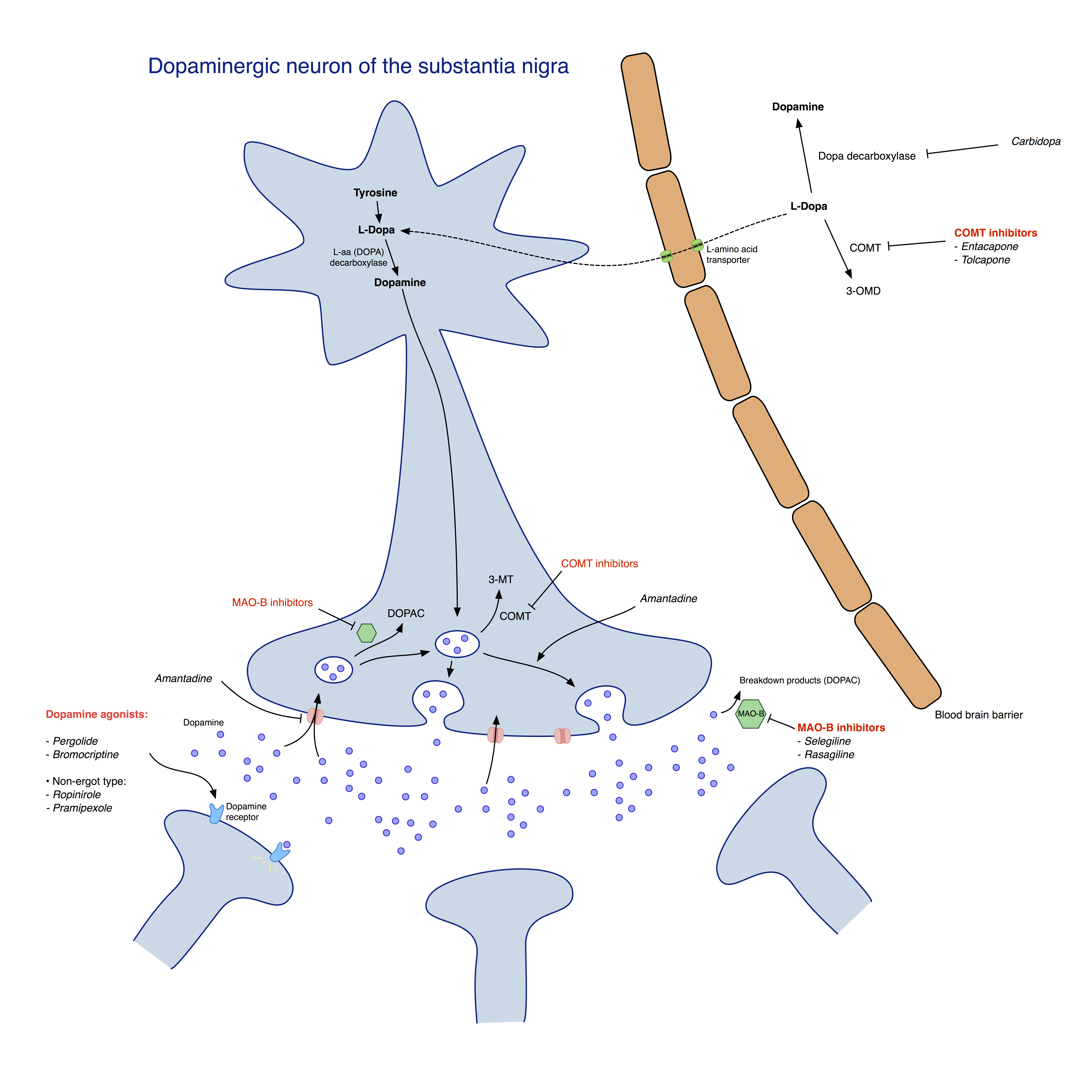|
Antiparkinsonian Agents
In the management of Parkinson's disease, due to the chronic nature of Parkinson's disease (PD), a broad-based program is needed that includes patient and family education, support-group services, general wellness maintenance, exercise, and nutrition. At present, no cure for the disease is known, but medications or surgery can provide relief from the symptoms. While many medications treat Parkinson's, none actually reverses the effects of the disease. Furthermore, the gold-standard treatment varies with the disease state. People with Parkinson's, therefore, often must take a variety of medications to manage the disease's symptoms. Several medications currently in development seek to better address motor fluctuations and nonmotor symptoms of PD. However, none is yet on the market with specific approval to treat Parkinson's. Medication The main families of drugs useful for treating motor symptoms are levodopa, dopamine agonists, and MAO-B inhibitors. The most commonly used treatm ... [...More Info...] [...Related Items...] OR: [Wikipedia] [Google] [Baidu] |
Neurology
Neurology (from el, wikt:νεῦρον, νεῦρον (neûron), "string, nerve" and the suffix wikt:-logia, -logia, "study of") is the branch of specialty (medicine), medicine dealing with the diagnosis and treatment of all categories of conditions and disease involving the brain, the spinal cord and the peripheral nerves. Neurological practice relies heavily on the field of neuroscience, the scientific study of the nervous system. A neurologist is a physician specializing in neurology and trained to investigate, diagnose and treat neurological disorders. Neurologists treat a myriad of neurologic conditions, including stroke, seizures, movement disorders such as Parkinson's disease, autoimmune neurologic disorders such as multiple sclerosis, headache disorders like migraine and dementias such as Alzheimer's disease. Neurologists may also be involved in clinical research, clinical trials, and basic research, basic or translational research. While neurology is a nonsurgical sp ... [...More Info...] [...Related Items...] OR: [Wikipedia] [Google] [Baidu] |
Carbidopa
Carbidopa (Lodosyn) is a drug given to people with Parkinson's disease in order to inhibit peripheral metabolism of levodopa. This property is significant in that it allows a greater proportion of administered levodopa to cross the blood–brain barrier for central nervous system effect, instead of being peripherally metabolised into substances unable to cross said barrier. Pharmacology Carbidopa inhibits aromatic-L-amino-acid decarboxylase (DOPA decarboxylase or DDC), an enzyme important in the biosynthesis of L-tryptophan to serotonin and in the biosynthesis of L-DOPA to dopamine (DA). DDC exists both outside of (body periphery) and within the confines of the blood–brain barrier. Carbidopa is used in the treatment of, among other diseases, Parkinson's disease (PD), a condition characterized by death of dopaminergic neurons in the substantia nigra. Increased dopamine availability may increase the effectiveness of the remaining neurons and alleviate symptoms for a ... [...More Info...] [...Related Items...] OR: [Wikipedia] [Google] [Baidu] |
Apomorphine
Apomorphine, sold under the brand name Apokyn among others, is a type of aporphine having activity as a non- selective dopamine agonist which activates both D2-like and, to a much lesser extent, D1-like receptors. It also acts as an antagonist of 5-HT2 and α-adrenergic receptors with high affinity. The compound is historically a morphine decomposition product made by boiling morphine with concentrated acid, hence the ''-morphine'' suffix. Contrary to its name, apomorphine does not actually contain morphine or its skeleton, nor does it bind to opioid receptors. The ''apo-'' prefix relates to it being a morphine derivative ("omesfrom morphine"). Historically, apomorphine has been tried for a variety of uses, including as a way to relieve anxiety and craving in alcoholics, an emetic (to induce vomiting), for treating stereotypies (repeated behaviour) in farmyard animals, and more recently in treating erectile dysfunction. Currently, apomorphine is used in the treatment of Pa ... [...More Info...] [...Related Items...] OR: [Wikipedia] [Google] [Baidu] |
Bromocriptine
Bromocriptine, originally marketed as Parlodel and subsequently under many brand names, is an ergoline derivative and dopamine agonist that is used in the treatment of pituitary tumors, Parkinson's disease, hyperprolactinaemia, neuroleptic malignant syndrome, and, as an adjunct, type 2 diabetes. It was patented in 1968 and approved for medical use in 1975. Medical uses Bromocriptine is used to treat acromegaly and conditions associated with hyperprolactinemia like amenorrhea, infertility, hypogonadism, and prolactin-secreting adenomas. It is also used to prevent ovarian hyperstimulation syndrome For label updates seFDA index page for NDA 017962 and to treat Parkinson's disease. Since the late 1980s it has been used, off-label, to reduce the symptoms of cocaine withdrawal but the evidence for this use is poor. A quick-release formulation of bromocriptine, Cycloset, is also used to treat type 2 diabetes.. For label updates seFDA index page for NDA 020866 When administered within ... [...More Info...] [...Related Items...] OR: [Wikipedia] [Google] [Baidu] |
Selegiline
Selegiline, also known as L-deprenyl and sold under the brand names Eldepryl and Emsam among others, is a medication which is used in the treatment of Parkinson's disease and major depressive disorder. It is provided in the form of a capsule or tablet taken by mouth for Parkinson's disease and as a patch applied to skin for depression. Selegiline acts as a monoamine oxidase inhibitor, and increases levels of monoamine neurotransmitters in the brain. At typical clinical doses used for Parkinson's disease, selegiline is a selective and irreversible inhibitor of monoamine oxidase B (MAO-B), increasing levels of dopamine in the brain. In larger doses (more than 20 mg/day), it loses its specificity for MAO-B and also inhibits MAO-A, which increases serotonin and norepinephrine levels in the brain. Medical uses Parkinson's disease In its pill form, selegiline is used to treat symptoms of Parkinson's disease. [...More Info...] [...Related Items...] OR: [Wikipedia] [Google] [Baidu] |



